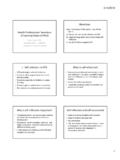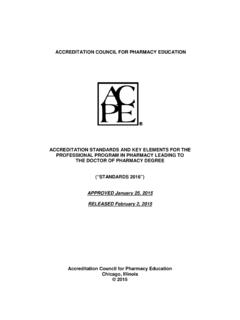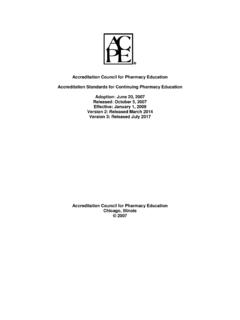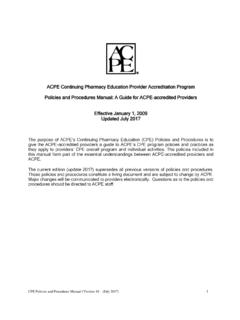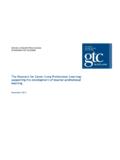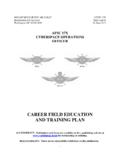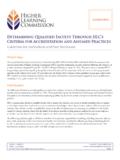Transcription of Accreditation Council for Pharmacy Education …
1 Accreditation Council for Pharmacy Education guidance on continuing professional development (CPD) for the Profession of Pharmacy In January 2015, the ACPE Board of Directors adopted a revised Definition of continuing Education for the Profession of Pharmacy which better describes the quality of continuing Pharmacy Education (CPE) required by ACPE and assists accredited providers of CPE in planning activities applicable to the professional development of pharmacists and Pharmacy technicians. CPE, as defined by ACPE, is an integral and essential component of the broader approach to learning that is continuing professional development (CPD).
2 continuing professional development provides a process for pharmacists and Pharmacy technicians to meet and maintain defined competencies in areas relevant to their respective professional responsibilities, Center for the Advancement of Pharmacy Education (CAPE) Educational Outcomes (2013), Pharmacy Technician Certification Board (PTCB) knowledge statements (2013) [Appendix A]. continuing Pharmacy Education (CPE): A structured educational activity designed or intended to support the continuing development of pharmacists and/or Pharmacy technicians to maintain and enhance their competence.
3 continuing Pharmacy Education (CPE) should promote problem-solving and critical thinking and be applicable to the practice of Pharmacy . continuing professional development (CPD): A self-directed, ongoing, systematic and outcomes-focused approach to lifelong learning that is applied into practice. It involves the process of active participation in formal and informal learning activities that assist in developing and maintaining competence, enhancing professional practice, and supporting achievement of career goals. The CPD approach is cyclical in nature where each stage of the process can be recorded in a personal learning portfolio.
4 The CPD Cycle Approved January 2015 Page 1 continuing professional development should include a wide variety of methods for attaining new knowledge, skills, attitudes, and values. CPD learning experiences should be based on an assessment of needs and goals (REFLECT), generated from a personal development plan with outcomes- based objectives (PLAN), and evaluated for achievement of objectives and personal and professional impact (EVALUATE). Key to the CPD approach is linking learning to practice (APPLY). REFLECT The REFLECT stage requires pharmacists to reflect on their personal and professional lives and self-assess their learning needs and goals.
5 Areas requiring professional development should be identified. It is important to pinpoint what specific knowledge or skills are needed. Peer assessment can offer valuable insights to assist a pharmacist in identifying true learning needs. PLAN The PLAN stage involves formulating a personal development plan to accomplish identified learning needs. Planning involves the process of defining learning objectives, learning activities, required resources and measures of success, and articulating the plan with colleagues to support learning over an extended period of time. Learning needs should be prioritized based on importance and urgency in order to guide development of a plan specifying both short-term and long-term goals.
6 LEARN and APPLY In the LEARN stage, the pharmacist puts the personal development plan into action to meet identified learning objectives utilizing an appropriate range of learning activities and methods. In the CPD model, the pharmacist is not limited to ACPE-accredited educational activities but may find relevant learning activities from other sources, such as academic programs, or specialized training courses. In the APPLY stage, learned knowledge, skills, attitudes, and values are then applied into practice. EVALUATE The EVALUATE stage involves the pharmacist assessing how successful the personal development plan has been in meeting stated learning needs by considering outcomes and impact.
7 If learning needs were not fully met, it may be possible to identify further development needs at this stage. Activities that resulted in practice changes or beneficial patient outcomes are analyzed. Personal evaluation leads to reflection, which continues the ongoing cyclical process of CPD. Documentation of each stage in the CPD cycle in a personal portfolio can support reflection and evaluation and provide evidence of the work involved to others ( employers, professors, regulatory agencies). The portfolio should be simple to use, readily accessible, and developed over time into a comprehensive record of learning experiences which acts as an ongoing tool for review and self-evaluation.
8 Approved January 2015 Page 2 continuing professional development (CPD) Activities: A multitude of educational activities exist in various formats and venues which may benefit pharmacists and Pharmacy technicians in their lifelong learning. Types of activities undertaken should be identified and prioritized through the planning process to address educational needs and gaps in practice. Activities that are planned, developed, and implemented by ACPE-accredited providers consistent with the Definition of continuing Education for the Profession of Pharmacy and CPE Standards and Policies can be awarded continuing Pharmacy Education credit.
9 Other types of educational activities and learning opportunities which do not constitute CPE can also prove valuable as part of one s continuing professional development . Attributes of experiences beneficial in CPD involve selecting learning opportunities in response to identified personal and professional needs and goals which relate to daily practice or areas of professional interest/preference and focus on specific learning objectives and associated outcomes. The CPD approach to self-directed lifelong learning allows for flexibility in selecting and engaging in learning activities that are most beneficial to one s particular practice, patient care, research, administration, industry, etc.
10 When creating a learning plan for professional development , activity selection should be based on the following criteria: The activity meets a defined or established educational need or career goal (REFLECT); The activity aids in achieving a specific learning objective included in the learning plan (PLAN); The activity links to meaningful professional development (LEARN); and Effectiveness of the activity is evaluated based on measurable outcomes and impact in practice (EVALUATE and APPLY) Categories and Examples of CPD Activities continuing Education An individual s professional learning needs and objectives may be addressed through engagement in formal, structured accredited educational activities.
